Enter into the Internal Developer Platform (IDP) world, a game-changing solution that empowers development teams to streamline workflows, optimize resource management, and enhance productivity.
Here is a comprehensive guide to building an Internal Developer Platform, demystifying its components, benefits, and best practices.
Understanding Internal Developer Platforms
The Role of Internal Developer Platforms in Modern Software Development
Internal Developer Platforms (IDPs) have emerged as a transformative force. They act as a bridge between developers, infrastructure, and tools, facilitating the entire software development lifecycle. An IDP is not just a set of tools but a comprehensive platform designed to streamline workflows, enhance collaboration, and accelerate software delivery.
At its core, an IDP provides developers with a centralized platform to build, deploy, and manage applications. It offers a unified interface for tasks such as code version control, continuous integration, continuous deployment (CI/CD), container orchestration, and resource management. This integration of essential tools into a single platform eliminates the need for developers to switch between disparate tools and interfaces, significantly boosting their productivity.
The Importance of Internal Developer Platforms
IDPs have gained significant importance in the context of modern software development for several compelling reasons:
- Efficiency: With IDPs, development teams can work more efficiently. They can focus on writing code and delivering features instead of grappling with the complexities of infrastructure management.
- Streamlined Workflows: IDPs streamline development workflows by providing a standardized and automated way to build, test, and deploy applications. This consistency ensures that applications move seamlessly from development to production environments.
- Resource Management: Resource allocation and optimization are critical in the world of cloud-native applications. IDPs help organizations efficiently allocate resources, preventing over-provisioning and unnecessary costs.
- Scalability: Modern applications need to scale rapidly to meet user demands. IDPs, often built on container orchestration platforms like Kubernetes, enable automatic scaling to handle increased workloads without manual intervention.
- Collaboration: Collaboration between development, operations, and quality assurance teams is paramount. IDPs facilitate this collaboration by providing a shared platform and tools for communication and coordination.
Internal Developer Platforms represent a fundamental shift in how organizations approach software development. They empower development teams to focus on innovation, code quality, and delivering value to end-users while abstracting away the complexities of infrastructure management.
Benefits and Features of Internal Developer Platforms
Key Features of Internal Developer Platforms
Internal Developer Platforms are characterized by a set of key features and functionalities that collectively empower development teams. These features include:
- Version Control: IDPs provide robust version control systems that enable developers to manage and track changes to their codebase. Git, a distributed version control system, is often integrated into IDPs, allowing developers to collaborate effectively.
- Continuous Integration and Continuous Deployment (CI/CD): IDPs automate the CI/CD pipeline, ensuring that code changes are automatically built, tested, and deployed. This automation reduces manual errors, accelerates release cycles, and improves code quality.
- Container Orchestration: Containerization, often powered by Kubernetes, is a cornerstone of IDPs. Containers package applications and their dependencies, ensuring consistent behavior across various environments. As a container orchestration platform, Kubernetes simplifies container management, scaling, and deployment.
- Resource Management: IDPs offer tools for efficient resource management. This includes infrastructure as code (IaC) to define and provision resources programmatically. Developers can request and allocate resources as needed, optimizing resource utilization.
- Monitoring and Observability: Monitoring and observability tools are integrated into IDPs to provide real-time insights into application performance. Metrics, logs, and traces help developers identify issues and improve application reliability.
Benefits of Using Internal Developer Platforms
The adoption of IDPs yields a multitude of advantages for development teams and organizations:
- Enhanced Developer Productivity: IDPs streamline workflows, allowing developers to focus on writing code rather than managing infrastructure. This increased productivity translates into faster feature delivery.
- Accelerated Workflows: Automation and integration within IDPs significantly speed up development and deployment workflows. Developers can commit code with confidence, knowing that automated tests and deployments are in place.
- Resource Efficiency: IDPs promote resource efficiency by automating resource allocation and scaling. Organizations can optimize cloud spending by only using the resources they need.
- Consistency: IDPs enforce best practices and consistency across development environments. This consistency ensures that applications behave predictably in different environments, reducing the chances of production issues.
- Improved Collaboration: IDPs foster collaboration among cross-functional teams. Developers, operators, and quality assurance teams can work together seamlessly within the same platform.
Realizing the Potential of IDPs
To fully harness the benefits of IDPs, organizations must invest in the right tools, infrastructure, and practices. The subsequent sections of this comprehensive guide will delve into the essential building blocks, design principles, implementation steps, and ongoing management of IDPs.
Building Blocks of an IDP
Essential Components for Building an IDP
Building a robust Internal Developer Platform requires careful consideration of the fundamental components that make up the platform. These components serve as the building blocks for creating an IDP tailored to your organization's needs. Let's explore these essential building blocks:
- Tools and Services: The foundation of an IDP consists of a curated set of tools and services that cater to the needs of development teams. These tools encompass version control systems, CI/CD pipelines, container orchestration platforms, and monitoring solutions.
- Infrastructure: An IDP relies on a well-defined infrastructure, typically hosted in the cloud. Cloud providers such as Amazon Web Services (AWS), Microsoft Azure, and Google Cloud Platform (GCP) offer the scalable resources required to support modern applications.
- Containers: Containers are a core element of IDPs. They encapsulate applications and their dependencies, ensuring consistency across different environments. Kubernetes, an open-source container orchestration platform, is commonly used to manage containers within IDPs.
- Automation: Automation is a fundamental principle of IDPs. It encompasses the automation of repetitive tasks, such as code building, testing, and deployment. Infrastructure as code (IaC) tools like Terraform and Ansible automate the provisioning of infrastructure resources.
- Integration: IDPs thrive on integration. Seamless integration between various tools and components is essential to create a cohesive development environment. API-driven integration allows for the flow of data and actions between different parts of the IDP.
The Role of Kubernetes in IDPs
Kubernetes, often referred to as K8s, is a key enabler of IDPs due to its container orchestration capabilities. Let's explore why Kubernetes plays a crucial role in IDP architecture:
- Container Orchestration: Kubernetes excels at container orchestration, managing the deployment, scaling, and operation of application containers. This ensures that applications run consistently across different environments.
- Resource Management: Kubernetes provides resource management features, allowing organizations to allocate computing resources effectively. Resources can be dynamically scaled based on application demand, optimizing resource utilization.
- High Availability: Kubernetes supports high availability configurations, ensuring that applications are resilient to failures. It automatically redistributes workloads in the event of node failures, minimizing downtime.
- Scaling: IDPs need to accommodate varying workloads. Kubernetes offers automated scaling, allowing applications to scale up or down based on traffic or resource usage.
- Service Discovery and Load Balancing: Kubernetes simplifies service discovery and load balancing within IDPs. Applications can discover and communicate with other services seamlessly.
Kubernetes acts as the orchestration layer that abstracts away the complexities of managing containers and allows IDPs to provide a stable, scalable, and efficient development environment.
Designing Your IDP: Key Considerations
Scalability as a Design Principle
Scalability is a critical design consideration when developing your Internal Developer Platform (IDP). Modern applications often experience varying workloads, from routine traffic to unexpected spikes in usage. An IDP must be able to handle these fluctuations efficiently.
To achieve scalability within your IDP, consider the following principles:
- Horizontal Scaling: Design your IDP to support horizontal scaling, allowing you to add or remove resources as needed. Horizontal scaling is particularly relevant when dealing with containerized applications managed by Kubernetes. Kubernetes provides tools for horizontal pod autoscaling, enabling applications to scale automatically based on CPU or memory usage.
- Load Balancing: Implement load balancing to distribute incoming traffic evenly across multiple instances or nodes. Load balancers help ensure that no single component becomes a bottleneck, and they enhance the overall performance and availability of your IDP.
- Statelessness: Favor stateless design patterns when developing components of your IDP. Stateless components are easier to scale horizontally because they don't rely on local state. In contrast, stateful components may require more complex scaling strategies.
- Caching: Caching frequently accessed data can significantly reduce the load on your IDP. Consider implementing caching mechanisms for frequently requested resources, such as container images or commonly used libraries.
By designing your IDP with scalability in mind, you can accommodate growth and respond effectively to changing workloads.
Security in IDP Design
Security is a paramount consideration in IDP design. As an integral part of the software development process, your IDP should prioritize security from the ground up. Here are key security considerations:
- Role-Based Access Control (RBAC): Implement RBAC to control access to various components and features within your IDP. RBAC ensures that users have the appropriate permissions based on their roles and responsibilities.
- Encryption: Encrypt sensitive data at rest and in transit. Employ encryption protocols such as TLS/SSL to secure data transmissions and encryption mechanisms to protect data stored within your IDP.
- Authentication and Authorization: Use robust authentication mechanisms, such as multi-factor authentication (MFA), to verify user identities. Implement authorization controls to define what actions users can perform within the platform.
- Vulnerability Scanning: Regularly scan container images and dependencies for known vulnerabilities. Tools like Trivy and Clair can help identify security issues early in the development process.
- Compliance: Ensure that your IDP complies with relevant industry standards and regulations. Depending on your organization's requirements, compliance may be necessary for areas such as data privacy and security.
- Security Audits: Conduct regular security audits and penetration testing to identify and address potential vulnerabilities. Engage security experts to assess your IDP's security posture comprehensively.
Security is an ongoing concern, and your IDP's security posture should evolve to address emerging threats and vulnerabilities. By integrating security into the design of your IDP, you create a robust foundation for secure software development.
Building and Implementing Your Internal Developer Platform
Infrastructure Setup: A Step-by-Step Guide
Building and implementing your Internal Developer Platform (IDP) involves several crucial steps. Let's walk through the process from setting up the infrastructure to integrating developer tools:
- Selecting a Cloud Provider: Begin by choosing a cloud provider that aligns with your organization's needs. Major providers like Amazon Web Services (AWS), Microsoft Azure, and Google Cloud Platform (GCP) offer robust infrastructure options.
- Network Configuration: Set up the network infrastructure, including virtual private clouds (VPCs), subnets, and security groups. Ensure that network configurations adhere to security best practices.
- Container Orchestration: Deploy Kubernetes as the container orchestration platform. Kubernetes simplifies container management, scaling, and deployment. Configure the Kubernetes cluster to suit your application requirements.
- Resource Provisioning: Utilize infrastructure as code (IaC) tools like Terraform or AWS CloudFormation to provision computing resources programmatically. This approach ensures consistency and repeatability.
- Storage and Database Setup: Configure storage solutions, including block storage and object storage, to support your applications. Deploy databases and set up replication and backups as needed.
- CI/CD Pipeline: Implement a robust CI/CD pipeline using tools like Jenkins, GitLab CI/CD, or Travis CI. Define pipeline stages for building, testing, and deploying applications.
- Container Registry: Set up a container registry to store Docker images securely. Popular choices include Docker Hub, Amazon Elastic Container Registry (ECR), and Google Container Registry (GCR).
- Monitoring and Observability: Implement monitoring and observability tools to gain insights into application performance. Prometheus and Grafana are popular choices for Kubernetes monitoring.
- Logging and Tracing: Configure logging and tracing solutions to capture application logs and traces. Tools like Elasticsearch, Fluentd, and Kibana (EFK stack) facilitate log management.
- Integration with Developer Tools: Integrate developer tools such as integrated development environments (IDEs) and code repositories (e.g., Git) with your IDP. This integration streamlines developer workflows.
- Security Measures: Apply security best practices, including network segmentation, firewall rules, and access controls. Regularly update and patch software components to address security vulnerabilities.
- Documentation: Create comprehensive documentation for your IDP, including architecture diagrams, setup instructions, and best practices. Documentation is essential for onboarding and troubleshooting.
Managing and Maintaining Your Internal Developer Platform
Ongoing Management and Optimization
The work doesn't end once your Internal Developer Platform (IDP) is up and running; in fact, that's just the beginning. Effective management and ongoing optimization are essential to ensure that your IDP continues to meet the evolving needs of your development teams.
Resource Allocation and Monitoring
Proper resource allocation and monitoring are key aspects of IDP management:
- Resource Allocation: Continuously assess resource usage to ensure efficient allocation. Use tools like Kubernetes Horizontal Pod Autoscaling to automatically adjust resource allocation based on demand.
- Cost Management: Monitor cloud costs and identify opportunities for optimization. Leverage cost management tools provided by your cloud provider to track spending and optimize resource utilization.
- Performance Monitoring: Implement robust monitoring and alerting to detect performance issues proactively. Tools like Prometheus and Grafana provide real-time visibility into the health of your IDP.
Security and Compliance
Maintaining a strong security posture is an ongoing effort:
- Regular Updates: Stay vigilant about software updates and security patches. Regularly update the underlying operating system, container images, and dependencies to address known vulnerabilities.
- Incident Response: Develop an incident response plan to address security breaches or incidents promptly. Define roles and responsibilities for incident response and conduct drills to ensure readiness.
- Compliance Audits: Conduct regular compliance audits to ensure that your IDP aligns with industry standards and regulations. Address any compliance gaps promptly.
Scaling and Optimization
As your organization grows, your IDP may need to scale:
- Horizontal Scaling: Implement automated scaling mechanisms to accommodate increased workloads. Ensure that your IDP can scale horizontally to handle additional resources efficiently.
- Optimization: Continuously optimize your IDP based on performance metrics and resource utilization data. Identify bottlenecks and areas for improvement.
Documentation and Training
Maintaining up-to-date documentation is critical:
- Documentation: Regularly update your IDP documentation to reflect changes, best practices, and troubleshooting procedures. Documentation is invaluable for onboarding new team members.
- Training: Provide training and educational resources to your development teams. Ensure that they are proficient in using the IDP's features and tools effectively.
By actively managing and optimizing your IDP, you can ensure that it remains a valuable asset to your development teams and supports the organization's goals effectively.
Challenges and Solutions in IDP Implementation
Common Challenges
While Internal Developer Platforms (IDPs) offer numerous benefits, implementing them can present challenges. Here are some common hurdles and solutions:
- Complexity: IDP implementation can be complex, especially for organizations new to containerization and orchestration. Solution: Start with well-documented reference architectures and seek guidance from experts or consultants.
- Resource Management: Efficiently managing resources in a dynamic environment can be challenging. Solution: Implement resource quotas and limits within Kubernetes to prevent resource contention and overspending.
- Integration: Integrating various tools and services within the IDP can be time-consuming. Solution: Use well-established integrations and automation tools to streamline integration efforts.
- Security: Ensuring the security of the IDP and the applications it hosts is paramount. Solution: Implement a robust security strategy that includes access controls, vulnerability scanning, and regular audits.
- Scalability: Scaling the IDP to accommodate growth can be complex. Solution: Design the IDP with scalability in mind from the outset and leverage Kubernetes for automatic scaling.
- User Training: Getting development teams up to speed with the IDP's features can take time. Solution: Provide comprehensive training and documentation to onboard users effectively.
Strategies for Overcoming Challenges
To overcome these challenges, consider the following strategies:
- Start Small: Begin with a pilot project or a specific development team when implementing the IDP. This allows you to fine-tune the platform before scaling it across the organization.
- Collaboration: Foster collaboration between development, operations, and security teams. Clear communication and cooperation are essential for successful IDP implementation.
- Continuous Improvement: Embrace a culture of continuous improvement. Regularly assess the IDP's performance, gather feedback from users, and make iterative enhancements.
- External Support: If needed, seek external support from consultants or vendors experienced in IDP implementation. Their expertise can expedite the process and ensure best practices are followed.
- User Feedback: Actively solicit feedback from development teams using the IDP. Use this feedback to identify pain points and areas for improvement.
By addressing these challenges with a proactive approach and well-defined solutions, organizations can maximize the benefits of their IDPs and foster a more efficient development environment.
Best Internal Developer Platforms to Consider in 2023
The landscape of Internal Developer Platforms (IDPs) continues to evolve. Numerous platforms offer a range of features and capabilities to meet the diverse needs of development teams. Let's explore some of the best IDPs to consider in 2023:
1. Qovery

Qovery provides an innovative solution for building internal developer platforms. It offers a range of features, including seamless integration with major cloud providers, cloning environments features, provisioning new environments on pull requests, and enabling auto-deploy. Qovery provides usage reports, smart cost optimization, and a text-based template system, enhancing user experience and cost efficiency. With Qovery, teams can easily manage infrastructure, scale applications, and ensure continuous delivery. The platform's user-friendly interface and comprehensive documentation make it accessible to developers of all levels of expertise. Qovery empowers organizations to focus on their core development tasks while abstracting away the complexities of infrastructure management.
2. OpsLevel

OpsLevel is a uniform interface that lets developers manage everything from one place, including their tools, services, and systems. It offers comprehensive visibility into services, their dependencies, and the overall health of the system. OpsLevel provides valuable insights and analytics, helping teams make informed decisions and ensure system reliability. With its intuitive interface and robust monitoring capabilities, OpsLevel empowers organizations to effectively manage complex architectures and maintain high-quality services.
3. Humanitec
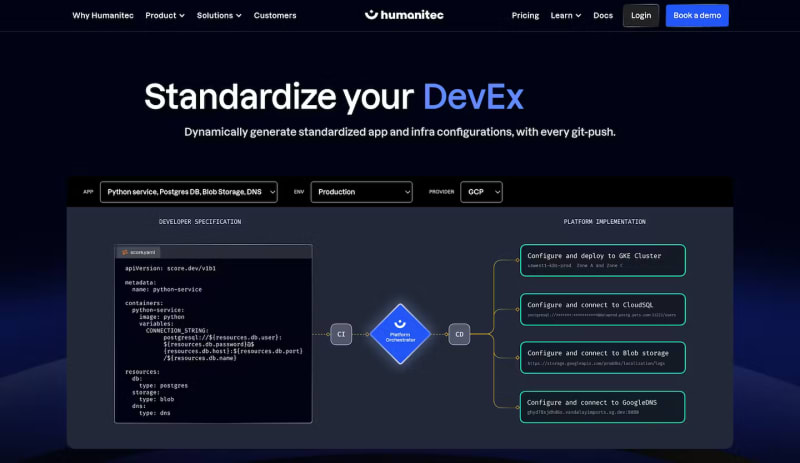
Humanitec is an internal developer platform that focuses on enabling self-service infrastructure for developers. It provides a unified dashboard for managing applications, environments, and configurations across different stages of the development lifecycle. With Humanitec, developers can easily define and deploy their infrastructure, reducing dependencies on operations teams. The platform's simplicity and automation capabilities allow organizations to achieve faster delivery cycles and improved collaboration between developers and operations teams.
4. Coherence
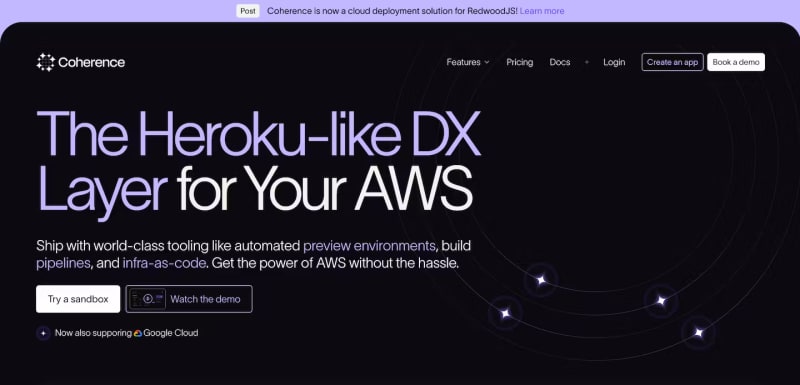
Coherence is more a PaaS platform that provides a full-cycle platform and enables the development, testing, and deployment of full-stack web apps, supporting and formalizing the full SDLC. Includes functionality to manage databases and other cloud resources in all environment types (dev/Cloud IDE, staging/ephemeral branch previews, & production).
5. Mia Platform

Mia Platform is a Developer Hub that manages the end-to-end life cycle of cloud-native applications and simplifies the life of Dev and Ops. it also provides a marketplace full of plug-and-play components to accelerate the construction of your own digital platform. Among its products, Mia-Platform Console is the core solution: it is a platform builder that industrializes development processes, accelerates the creation of microservices architectures, and improves the developer experience (DevX).
6. Portainer
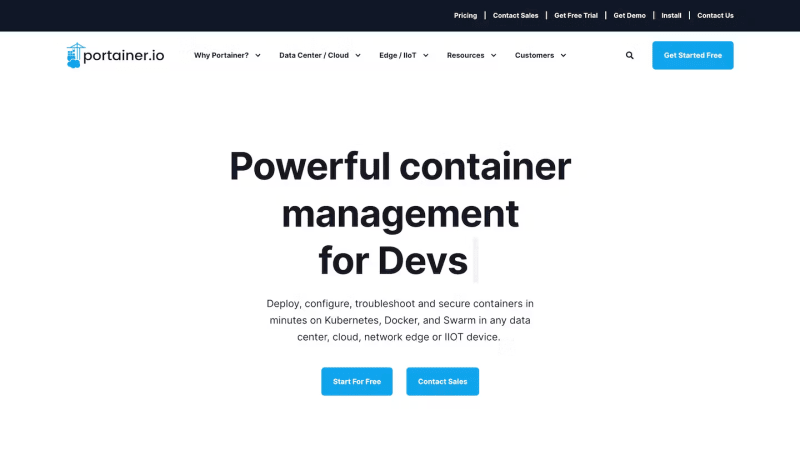
Portainer is an open-source tool that lets users set up, configure, and govern a container management portal that helps them get more value from Kubernetes sooner with the skills the team already has. With Portainer, you can manage any orchestrator, in the cloud, on-premise, or at the edge in a single interface.
7. Appvia
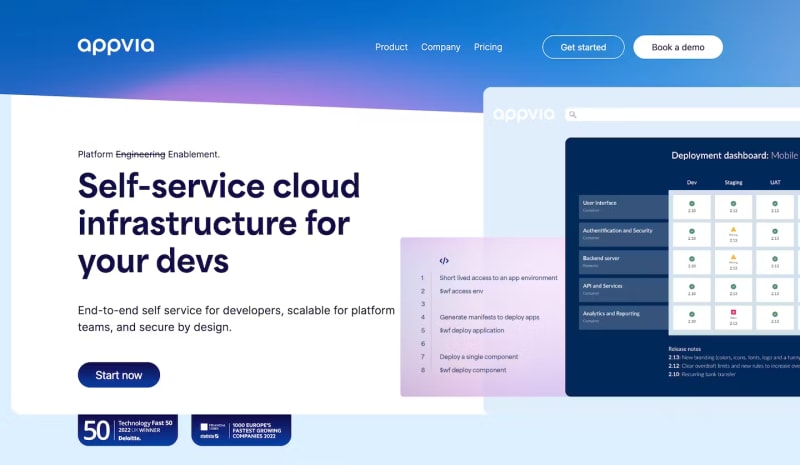
Appvia is a self-service cloud infrastructure platform designed to streamline software delivery processes. It offers a comprehensive set of features, including automated deployment, infrastructure management, and integration with major cloud providers. Appvia is dedicated to providing solutions that make public cloud delivery simple and secure. The solution empowers organizations to confidently pursue the cloud with solutions that make Kubernetes secure, cost-effective, and scalable.
8. Argonaut

Argonaut is a self-service deployment platform focused on simplifying complex development workflows. Argonaut was founded in 2021 with the mission of automating deployment workflows on the cloud. It empowers developers with self-service capabilities for tasks such as configuration, deployment, and application management. Argonaut.dev includes features like automated testing and continuous integration, making it a valuable choice for organizations looking to optimize their software development processes.
9. Nullstone
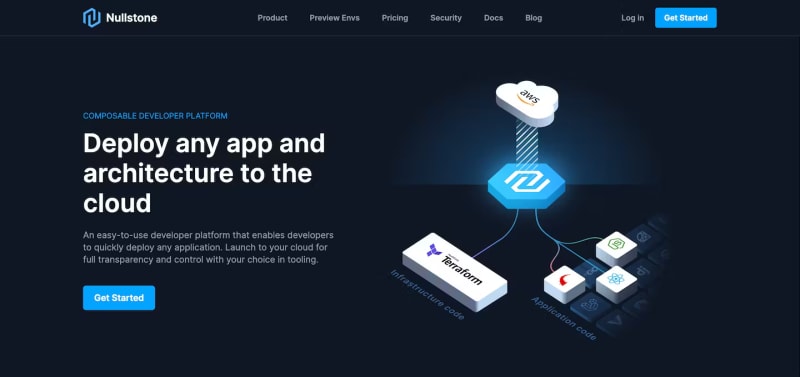
Nullstone is an internal developer platform that emphasizes self-service infrastructure management for developers. It offers a unified dashboard for managing applications and environments, streamlining the development lifecycle. Nullstone.io includes automation features and robust monitoring, enabling organizations to achieve faster delivery cycles and maintain high-quality services. It's a solution that promotes collaboration between development and operations teams, facilitating innovation and efficiency in software development.
10. Mogenius

Mogenius is an Internal Developer Platform designed to accelerate the digital transformation process for enterprises. Unlike many other platforms that focus solely on deployment or testing, Mogenius offers a complete array of services that cover the entire software development lifecycle. From rapid prototyping to full-scale production deployments, Mogenius aims to be a one-stop shop for all your development needs.
Conclusion
Internal Developer Platforms (IDPs) have become indispensable tools for modern software development. They offer a holistic approach to managing the entire software development lifecycle, from code creation to deployment and beyond. Understanding the fundamentals of IDPs, their benefits, and the critical components involved in their construction is essential for organizations looking to thrive in today's fast-paced software development landscape.
Embracing these platforms is not just an option but a strategic imperative. By doing so, organizations can boost developer productivity, enhance collaboration, and ultimately deliver higher-quality software to their customers. It's time to embark on your IDP journey and transform how you build, deploy, and manage software in 2023 and beyond.

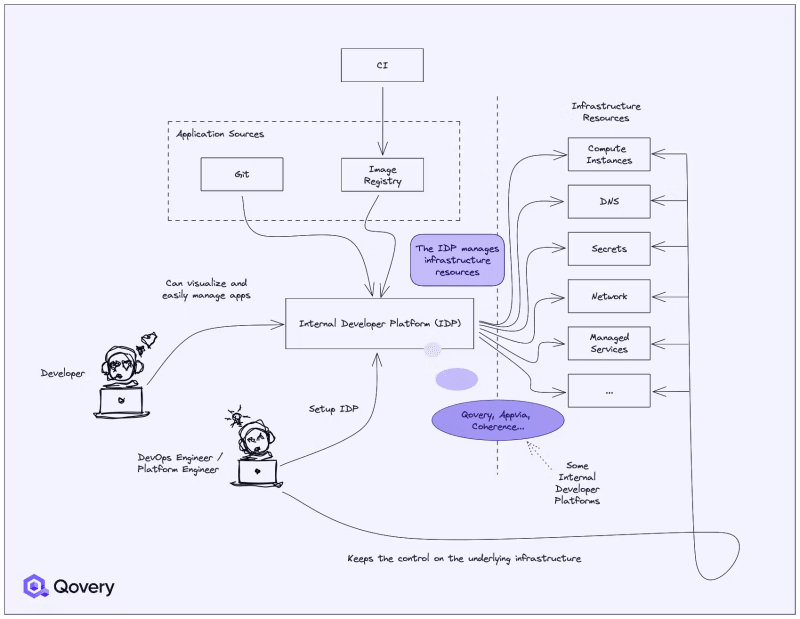

Top comments (0)